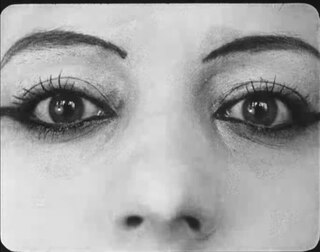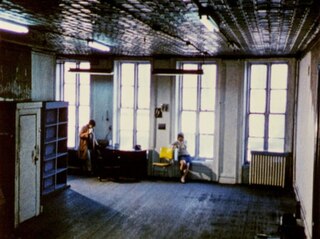Works
Nostalgia
In Nostalgia, still photographs taken by Frampton are slowly burned on a hot plate. Michael Snow reads personal comments by Frampton; however, the images are shifted such that photographs he discusses appear after the corresponding narration. [6]
Poetic Justice
Poetic Justice shows a stack of papers, on a table next to a plant and a cup of coffee. Page after page is placed on top of each other, forming a script that tells a surreal story. [7] At the suggestion of Nathan and Joan Lyons, Frampton published it as a book. [1]
Critical Mass
Critical Mass shows a domestic argument between two characters. It begins with a dark screen and only audio, leading into the main section where the image track is fixed-length segments that partially repeat over each other and the sound track is edited to move in and out of sync with the image. [8] The film was Frampton's first time working with actors. He cast Barbara DiBenedetto and Frank Albetta from Binghamton University as the couple and had them improvise based on a premise he wrote. They shot it in a single take. [1] The film's title comes from critical mass, the smallest amount of nuclear fuel needed to sustain a chain reaction. [8]
Travelling Matte
Travelling Matte began as video of Binghamton University that Frampton shot on a Portapak. He refilmed the footage on a television, manipulating the image with his hand between the camera and the screen. [9] The film's title refers to a travelling matte, a filmmaking technique where a changing shape is used to merge more than one image. [10]
Ordinary Matter
Ordinary Matter shows moving images of landscapes and monuments. Frampton shot much of the footage during a trip to England. For the film's soundtrack, he read through the Chinese syllables in a Wade–Giles table, but without intonation. Its title comes from ordinary matter, matter that makes up nearly all the observable universe. [11]
Remote Control
Remote Control is divided into five sections, each of which uses the same 100-foot reel as its source footage. Frampton filmed television broadcasts one frame at a time whenever the shot changed or panned. The five sections modify the footage in different ways and use different schematizations for displaying numbers from 0 to 40. [12]
Special Effects

Special Effects shows only a white dotted outline of a rectangle which moves around a black background. [13] It is accompanied by a synthesized soundtrack. [14] Frampton created the film by shooting a static image from a distance with a handheld telephoto lens, such that the slight tremor of his body is rendered as the motion of the rectangle. [15]






